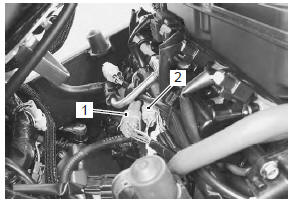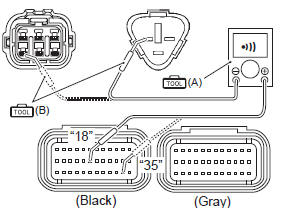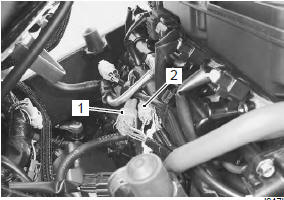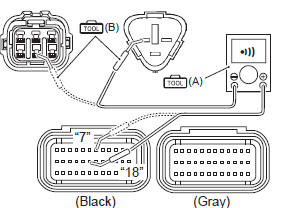Suzuki GSX-R 1000 Service Manual: DTC “c29” (p1654-h/l): secondary throttle position sensor (stps) circuit malfunction
Detected condition and possible cause
|
Detected condition |
Possible cause |
||
| C29 | Output voltage is not within the following
range. Difference between actual throttle opening and opening calculated by ecm is larger than specified value. 0.15 V ≤ Sensor voltage < 4.85 V |
|
|
| P1654 | H | Sensor voltage is higher than specified value. | |
| L | Sensor voltage is lower than specified value. | ||
Wiring diagram

Troubleshooting
| Caution when using the multi-circuit tester, do not strongly touch the terminal of the ecm coupler with a needle pointed tester probe to prevent terminal damage. |
| Note after repairing the trouble, clear the dtc using sds tool. Refer to “use of sds diagnosis reset procedures” . |
C29 (use of mode select switch)
|
Step |
Action |
Yes |
No |
|
1 |
Special tool Tester knob indication
voltage ( Stp sensor input voltage 4.5 – 5.5 V ((+) terminal: r – (–) terminal: ground, (+) terminal: r – (–) terminal: b/br)
Is the voltage ok? |
Go to step 3. |
|
P1654-h (use of sds)
|
Step |
Action |
Yes |
No |
|
1 |
Special tool Tester knob indication
continuity (
Special tool
(a):
(b):
Tester knob indication
continuity test ( Ecm couplers (harness side)
Is the continuity ok? |
Go to step 3. | Y/w wire shorted to vcc, or b/br wire open. |
P1654-l (use of sds)
|
Step |
Action |
Yes |
No |
|
1 |
Special tool Tester knob indication
continuity test (
Special tool Tester knob indication
continuity test ( Ecm couplers (harness side)
Is the continuity ok? |
Go to step 2. | R or y/w wire open, or y/w wire shorted to ground. |
|
2 |
Special tool
Tester knob indication
voltage ( Stp sensor input voltage 4.5 – 5.5 V ((+) terminal: r – (–) terminal: ground, (+) terminal: r – (–) terminal: b/br)
Is the voltage ok? |
Go to step 3. | Open or short circuit in the r or b/br wire. |
|
3 |
Special tool Tester knob indication
voltage ( Stp sensor output voltage secondary throttle valve is closed: approx. 0.7 V secondary throttle valve is opened: approx. 4.1 V ((+) terminal: y/w – (–) terminal: b/br)
Is the voltage ok? |
|
If check result is not satisfactory, replace the stp sensor with a new one. Refer to “stp sensor removal and installation” in section 1c . |
 DTC “c28” (p1655): secondary throttle
valve actuator (stva) malfunction
DTC “c28” (p1655): secondary throttle
valve actuator (stva) malfunction
Detected condition and possible cause
Detected condition
Possible cause
The operation voltage does not reach the stva.
Ecm does not receive communication signal from the ...
 DTC “c31” (p0705): gp switch circuit
malfunction
DTC “c31” (p0705): gp switch circuit
malfunction
Detected condition and possible cause
Detected condition
Possible cause
No gear position switch voltage
Gp switch voltage is not within the following range.
Gp switch ...
Other materials:
Foreword
Motorcycling is one of the most
exhilarating sports and to ensure
your riding enjoyment, you should
become thoroughly familiar with
the information presented in this
owner's manual before riding the
motorcycle.
The proper care and maintenance
that your motorcycle requires is
outlined in t ...
Headlight
To replace the headlight bulbs,
perform the following steps:
Upper light bulb
Remove the bolt 1 to lift the
instrument panel 2.
Turn the cap 3 counterclockwise
and remove it.
Unhook the bulb holder spring
4 and pull out the socket 5.
Pull off the bulb from ...
Precautions
Keep away from fire or spark.
During disassembling, use care to minimize spillage of
gasoline.
Spilled gasoline should be wiped off immediately.
Work in a well-ventilated area.
For e-33 models, drain fuel from the fuel tank before
...


 (a): 09900–25008 (multi
(a): 09900–25008 (multi
 )
)

 (a): 09900–25008 (multi
(a): 09900–25008 (multi
 )
)




 )
)


